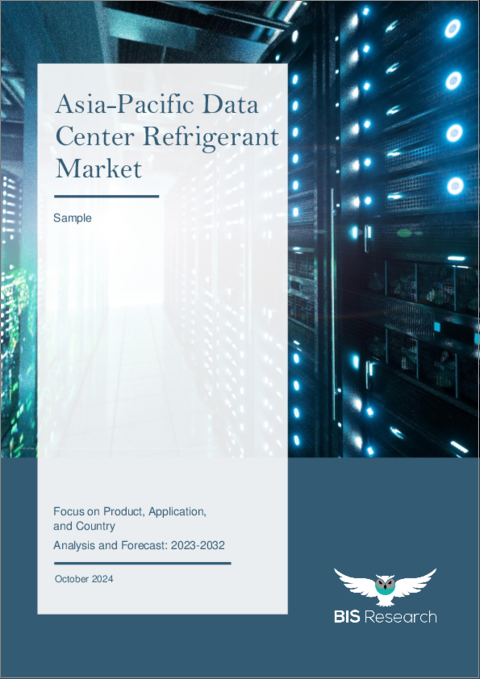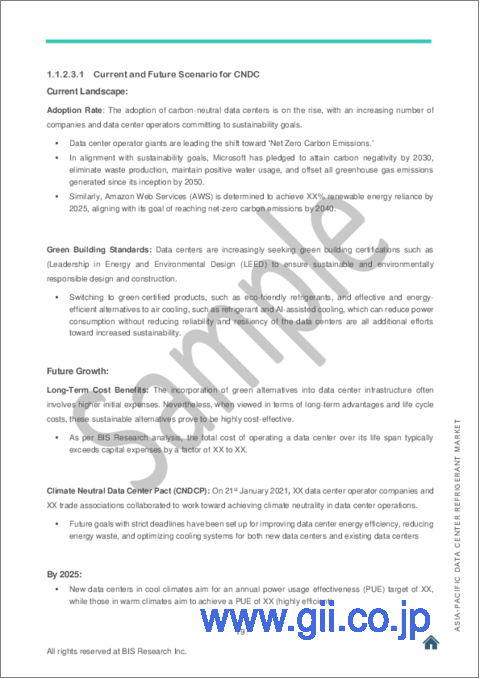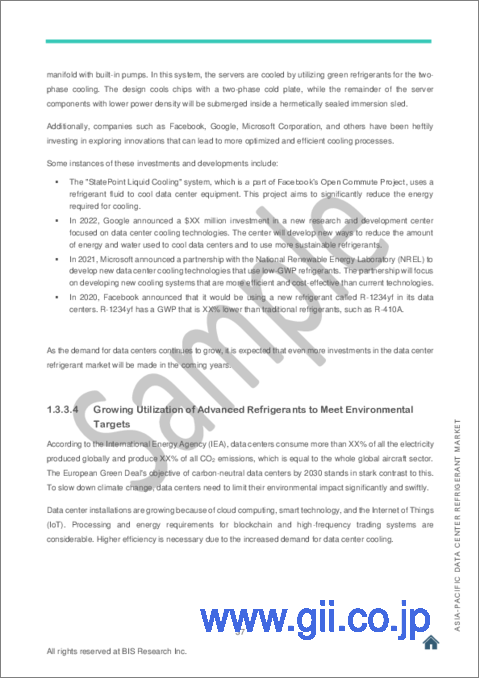|
|
市場調査レポート
商品コード
1575555
アジア太平洋のデータセンター用冷媒市場:製品別、用途別、国別 - 分析と予測(2023年~2032年)Asia-Pacific Data Center Refrigerant Market: Focus on Product, Application, and Country - Analysis and Forecast, 2023-2032 |
||||||
カスタマイズ可能
|
|||||||
| アジア太平洋のデータセンター用冷媒市場:製品別、用途別、国別 - 分析と予測(2023年~2032年) |
|
出版日: 2024年10月22日
発行: BIS Research
ページ情報: 英文 92 Pages
納期: 1~5営業日
|
全表示
- 概要
- 図表
- 目次
アジア太平洋のデータセンター用冷媒の市場規模(中国を除く)は、2023年の1億170万米ドルから2032年には2億8,810万米ドルに成長すると予測され、予測期間の2023年~2032年のCAGRは11.00%になるとみられています。
アジア太平洋のデータセンター用冷媒市場は、データセンター数の増加とエネルギー効率の高い運用を奨励する政府プログラムによって発展すると予測されています。さらに、地域の財政的インセンティブや規制法によって、持続可能性の目標に沿ったデータセンター施設での環境に優しい冷媒の使用が促進されています。
| 主要市場統計 | |
|---|---|
| 予測期間 | 2023年~2032年 |
| 2023年の評価 | 1億170万米ドル |
| 2032年の予測 | 2億8,810万米ドル |
| CAGR | 11% |
アジア太平洋のデータセンター用冷媒市場の大幅な拡大には、各地域でのデータセンター数の増加と、エネルギー効率の高い運用を奨励する政府の取り組みが寄与すると予想されます。デジタル化プロジェクト、クラウドコンピューティング、データ駆動型技術によってもたらされたデータセンター・インフラの成長により、これらの施設で発生する熱を制御するための効果的な冷却システムが必要となっています。理想的な温度を維持し、データセンターの一貫した信頼できる運用を保証するためには、冷媒が不可欠です。
中国、日本、インドなどのアジア太平洋諸国政府は、世界の持続可能性の目標をサポートする環境に優しい冷媒の使用を促進する法律を制定し、財政的なインセンティブを提供しています。エネルギー効率が高く、GWP(地球温暖化係数)の低い冷媒の使用を奨励することで、これらのプログラムはデータセンターの環境負荷低減を支援します。
データセンター事業者が持続可能性を重視するようになるにつれ、環境にやさしく法的適合性の高い冷媒など、最先端の冷却ソリューションに対するニーズが高まると予想されます。今後数年間、冷媒市場は、新規および既存のデータセンターに対するアジア太平洋地域の持続的な投資によってさらに牽引されると予測されます。
当レポートでは、アジア太平洋のデータセンター用冷媒市場について調査し、市場の概要とともに、製品別、用途別、国別の動向、および市場に参入する企業のプロファイルなどを提供しています。
目次
エグゼクティブサマリー
第1章 市場
- 業界見通し
- エコシステム/進行中のプログラム
- ビジネスダイナミクス
- サプライチェーン分析
- 価格分析
第2章 地域
- データセンターの見通し
- 中国
- アジア太平洋と日本
第3章 市場-競合ベンチマーキングと企業プロファイル
- 競合ベンチマーキング
- 企業プロファイル
- DAIKIN INDUSTRIES, Ltd.
第4章 調査手法
List of Figures
- Figure 1: Properties of Hydrogen, Fluorine, and Chlorine Refrigerants
- Figure 2: Phase-Out Schedules for HCFCs and HFCs
- Figure 3: Asia-Pacific Data Center Refrigerant Market, $Million, 2022-2032
- Figure 4: Asia-Pacific Data Center Refrigerant Market (by Industry), $Million, 2022 and 2032
- Figure 5: Asia-Pacific Data Center Refrigerant Market (by Data Center Type), $Million, 2022 and 2032
- Figure 6: Asia-Pacific Data Center Refrigerant Market (by Refrigerant Type), $Million, 2022 and 2032
- Figure 7: Asia-Pacific Data Center Refrigerant Market (by Cooling Type), $Million, 2022 and 2032
- Figure 8: Asia-Pacific Data Center Refrigerant Market (by Deployment), $Million, 2022 and 2032
- Figure 9: Data Center Refrigerant Market (by Region), 2022
- Figure 10: Scope Definition
- Figure 11: Hyperscale Data Center Capacity (by Region), MW, 2021
- Figure 12: Anticipated Energy Consumption, by Data Center Types, TWh, 2023
- Figure 13: Power Flows in a typical Data Center:
- Figure 14: Pathway to Carbon Neutrality in Data Centers
- Figure 15: Key Factors for Assessing Infrastructure Cost in a Data Center Project
- Figure 16: CAPEX Comparison: Traditional Data Centers (TDC) Vs Carbon Neutral Data Centers (CNDC)
- Figure 17: Key Factors for Assessing Energy Cost in Data Center Project
- Figure 18: OPEX Comparison: Traditional Data Centers (TDC) Vs Carbon Neutral Data Centers (CNDC):
- Figure 19: Major Countries' Share of Total Installed Renewable Capacity, 2021
- Figure 20: Trend in Industrial Refrigeration
- Figure 21: Estimated Capital Expense for Various Data Center Cooling Technologies
- Figure 22: Some Criteria Followed by Data Centers while Choosing Refrigerants
- Figure 23: GWP and ODP of Most Common Refrigerants in Data Centers
- Figure 24: Estimated Worldwide 5G Adoption as a Share of Total Mobile Connections (Excluding IoT)
- Figure 25: Share of Data Center (by Country), 2022
- Figure 26: Water Utility and Wastewater Cost Comparison in Data Centers, 2021
- Figure 27: Cooling Efficiency and Water Usage of Data Center Cooling Technologies
- Figure 28: Energy Distribution in a Typical Data Center, 2022
- Figure 29: Evolution of Refrigerants from 1830 and Future Anticipations
- Figure 30: Data Center Web Traffic, Zettabytes per Year, 2016-2021
- Figure 31: Data Center pPue Analysis
- Figure 32: Supply Chain Analysis of Data Center Refrigerant Market
- Figure 33: Competitive Benchmarking Matrix
- Figure 34: Data Center Refrigerant Market: Research Methodology
- Figure 35: Data Triangulation
- Figure 36: Top-Down and Bottom-Up Approach
- Figure 37: Assumptions and Limitations
List of Tables
- Table 1: Advantages and Disadvantages of Non-PFAS Refrigerants
- Table 2: Regulations Impacting the Data Center Refrigerant Market
- Table 3: Government Initiatives and Impacts
- Table 4: Recent Developments by Leading Companies toward Data Center Cooling, 2019-2023
- Table 5: Key Companies and Developments toward Neural Networks in Data Centers
- Table 6: Key Companies Exploring Indirect Thermosyphon Cooling
- Table 7: Data Center Refrigerant Pricing
- Table 8: Data Center Refrigerant Market (by Region), $Million, 2022-2032
- Table 9: DAIKIN INDUSTRIES, Ltd.: Product Portfolio
Introduction to Asia-Pacific Data Center Refrigerant Market
The Asia-Pacific data center refrigerant market (excluding China) is expected to grow from $101.7 million in 2023 to $288.1 million by 2032, at a CAGR of 11.00% during the forecast period 2023-2032. The APAC data center refrigerant market is anticipated to develop because to the rising number of data centers and government programs encouraging energy-efficient operations. Additionally, regional financial incentives and regulatory laws are promoting the use of environmentally friendly refrigerants in data center facilities in accordance with sustainability goals.
Market Introduction
| KEY MARKET STATISTICS | |
|---|---|
| Forecast Period | 2023 - 2032 |
| 2023 Evaluation | $101.7 Million |
| 2032 Forecast | $288.1 Million |
| CAGR | 11% |
The growing number of data centers around the area and government initiatives to encourage energy-efficient operations are expected to propel the APAC data center refrigerant market's substantial expansion. The growth of data center infrastructure brought about by digital transfoarmation projects, cloud computing, and data-driven technologies has made effective cooling systems necessary to control the heat produced by these establishments. In order to maintain ideal temperatures and guarantee the consistent and dependable operation of data centers, refrigerants are essential.
The governments of APAC nations, such as China, Japan, and India, are enacting laws and providing financial incentives to promote the use of environmentally benign refrigerants that support the objectives of global sustainability. By encouraging the use of energy-efficient and low-GWP (Global Warming Potential) refrigerants, these programs assist data centers in lowering their environmental impact.
The need for cutting-edge cooling solutions, such as environmentally friendly and legally compatible refrigerants, is anticipated to increase as data center operators place a higher priority on sustainability. In the upcoming years, the refrigerant market is anticipated to be further driven by the APAC region's anticipated sustained investments in both new and existing data centers.
Market Segmentation
Segmentation 1: by Industry
- IT and Telecom
- Banking
- Financial Services and Insurance (BFSI)
- Research and Healthcare
- Retail
- Manufacturing
- Others
Segmentation 2: by Data Center Type
- Hyperscale
- Colocation
- Edge Data Center
- Enterprise
Segmentation 3: by Refrigerant Type
- Conventional Refrigerants
- Liquid Cooling Fluids
Segmentation 4: by Cooling Type
- Air Cooling
- Liquid Cooling
- Free Cooling
Segmentation 5: by Deployment
- Installation/OEM
- Aftermarket
Segmentation 6: by Region
- Asia-Pacific and Japan
- China
How can this report add value to an organization?
Product/ Innovation Strategy: In the APAC data center refrigerant market, a strategic focus on innovation drives product development. Collaborate with industry leaders to introduce eco-friendly refrigerants and advanced cooling technologies, meeting evolving regulatory standards. Leverage data analytics for real-time monitoring, optimizing cooling efficiency, and reducing environmental impact while ensuring operational excellence.
Growth/ Marketing Strategy: Utilize targeted marketing campaigns highlighting eco-friendly benefits and energy savings. Forge partnerships with data center operators and OEMs to expand reach and offer comprehensive solutions. Continuously innovate to stay ahead in the competitive landscape.
Competitive Strategy: Emphasizing differentiation and value proposition will be crucial for success in the market. Conduct thorough market analysis to identify niche segments and competitive advantages and position products accordingly. Forge alliances with key stakeholders and offer customizable solutions to meet diverse customer needs effectively.
Table of Contents
Executive Summary
1 Markets
- 1.1 Industry Outlook
- 1.1.1 Market Definition
- 1.1.2 Data Center Trends
- 1.1.2.1 Data Center Capacities: Current and Future
- 1.1.2.2 Data Center Power Consumption Scenario
- 1.1.2.3 Impact of Carbon-Neutral Data Center (CNDC) Operations on Data Center Refrigerant Market
- 1.1.2.3.1 Current and Future Scenario for CNDC
- 1.1.2.3.2 Alternative Solutions to Current HVAC Systems Used in Data Centers
- 1.1.2.3.3 Cost Analysis
- 1.1.2.3.3.1 Capital Expenditure (CAPEX)
- 1.1.2.3.3.1.1 Infrastructure Cost
- 1.1.2.3.3.2 Operational Expenditure (OPEX)
- 1.1.2.3.3.2.1 Energy Cost
- 1.1.2.3.4 Key Countries to Focus
- 1.1.2.4 Impact of United Nations Intergovernmental Panel on Climate Change on Data Center Market
- 1.1.2.4.1 Impact Assessment of United Intergovernmental Panel on Climate Change (IPCC)'s report
- 1.1.2.5 Impact of PFAS Refrigerant Ban on the Data Center Cooling Outlook
- 1.1.2.5.1 Alternative Cooling Solutions to PFAS Refrigerants
- 1.1.2.5.2 Advantages and Disadvantages of Non-PFAS Refrigerants
- 1.1.2.6 Data Center Cooling Strategies
- 1.1.2.6.1 Upcoming Data Center Refrigerant Concepts
- 1.1.2.7 Refrigerant Selection Criteria
- 1.1.2.8 Other Industrial Trends
- 1.1.2.8.1 HPC Cluster Developments
- 1.1.2.8.2 Blockchain Initiatives
- 1.1.2.8.3 Super Computing
- 1.1.2.8.4 5G and 6G Developments
- 1.1.2.8.5 Impact of Server/Rack Density
- 1.2 Ecosystem/Ongoing Programs
- 1.2.1 Important Regulations
- 1.2.2 Government Initiatives and Impacts
- 1.3 Business Dynamics
- 1.3.1 Business Drivers
- 1.3.1.1 Expanding Data Center Industry
- 1.3.1.1.1 Data Center Investment Landscape
- 1.3.1.1.1.1 Key Regional Data Center Investment Trend (2022-2023)
- 1.3.1.1.1 Data Center Investment Landscape
- 1.3.1.2 Sustainable Development Efforts and CSR Activities
- 1.3.1.2.1 The Green IT Cube
- 1.3.1.3 Growing Adoption of Alternate Cooling Solutions for Improved Water Usage Efficiency
- 1.3.1.4 Need for High Energy Efficiency
- 1.3.1.1 Expanding Data Center Industry
- 1.3.2 Business Challenges
- 1.3.2.1 Phasing out of PFAS Refrigerants
- 1.3.2.2 Intense Market Competition from Diverse Cooling Technology
- 1.3.2.3 Rapid Adoption of Refrigerants over Air Cooling Driven by its Advantages
- 1.3.2.3.1 Leading Hyperscale Data Centre Operators to Have a Huge Impact on Market Adoption
- 1.3.3 Business Opportunities
- 1.3.3.1 AI and Neural Network Implementation to Optimize Cooling
- 1.3.3.2 Growing Traction for Indirect Thermosyphon Cooling
- 1.3.3.3 Increase in Investments toward Data Center Cooling Innovations
- 1.3.3.4 Growing Utilization of Advanced Refrigerants to Meet Environmental Targets
- 1.3.3.5 Resurgence of Air-Cooled Chillers
- 1.3.1 Business Drivers
- 1.4 Supply Chain Analysis
- 1.5 Pricing Analysis
2 Regions
- 2.1 Data Center Outlook
- 2.2 China
- 2.3 Asia Pacific and Japan
- 2.3.1 Japan
- 2.3.2 Australia
- 2.3.3 India
- 2.3.4 Singapore
- 2.3.5 Rest of Asia Pacific
3 Markets - Competitive Benchmarking & Company Profiles
- 3.1 Competitive Benchmarking
- 3.2 Company Profiles
- 3.2.1 DAIKIN INDUSTRIES, Ltd.
- 3.2.1.1 Company Overview
- 3.2.1.2 Product Portfolio
- 3.2.1.3 Customer Profile
- 3.2.1.3.1 Target Customer Segments
- 3.2.1.3.2 Key Clients
- 3.2.1.4 Analyst View
- 3.2.1.4.1 Regions of Growth:
- 3.2.1 DAIKIN INDUSTRIES, Ltd.
4 Research Methodology
- 4.1 Data Sources
- 4.1.1 Primary Data Sources
- 4.1.2 Secondary Data Sources
- 4.1.3 Data Triangulation
- 4.2 Market Estimation and Forecast
- 4.2.1 Factors for Data Prediction and Modelling





